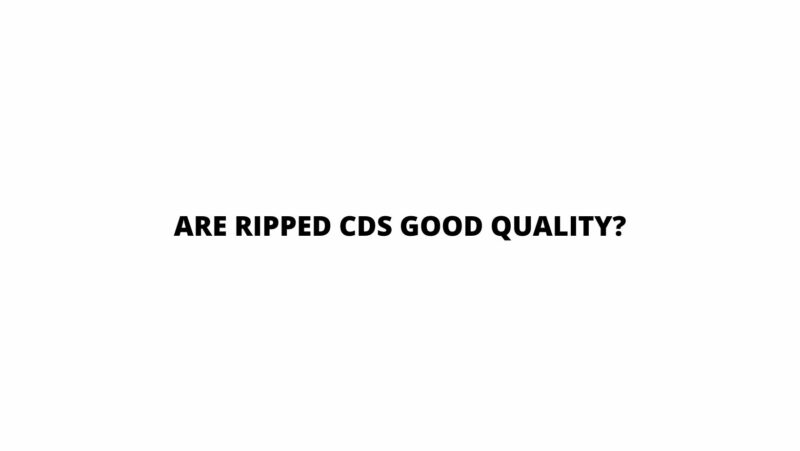As technology continues to shape the way we interact with music, the process of ripping CDs—converting physical audio discs into digital formats—has become a common practice. This practice offers convenience, portability, and preservation benefits. However, audiophiles and discerning music enthusiasts often raise questions about the quality of ripped CDs. In this article, we delve into the intricacies of audio quality in the context of CD ripping, examining the factors that affect the outcome and whether ripped CDs can truly meet the standards of audio excellence that audiophiles seek.
The Essence of Audio Quality
Before exploring the quality of ripped CDs, it’s crucial to understand what constitutes audio quality. Audio quality encompasses various aspects, including clarity, depth, dynamic range, frequency response, and the absence of artifacts or distortions. Achieving high audio quality is the goal of both audio engineers during recording and mixing and audiophiles during playback.
The Digital Ripping Process
When a CD is ripped, the process involves extracting digital audio data from the disc and encoding it into a digital format, such as FLAC or MP3. Theoretically, this process should yield audio files that faithfully represent the original CD audio. However, achieving high audio quality in ripped CDs requires careful attention to several factors.
Factors Influencing Ripped CD Audio Quality
- Bit-Perfect Ripping: The concept of bit-perfect ripping emphasizes a precise replication of the audio data without any alteration. Bit-perfect ripping ensures that the extracted audio file is an exact match to the data on the CD, guaranteeing accuracy and fidelity.
- Choice of Audio Format: The audio format selected during the ripping process can impact audio quality. Formats like FLAC and WAV offer lossless compression, preserving all the original audio data. On the other hand, formats like MP3 use lossy compression, sacrificing some audio data to reduce file size.
- Bitrate and Compression Settings: If using compressed formats like MP3, the chosen bitrate and compression settings influence audio quality. Higher bitrates generally result in better quality audio, although larger file sizes are a trade-off.
- Error Correction: Ripping software’s error correction mechanisms play a significant role in maintaining audio quality. These mechanisms correct errors that may arise due to scratches or imperfections on the CD.
- Sampling Rate: The sampling rate determines how often the audio signal is measured during the digital conversion process. A higher sampling rate can capture more nuances in the audio, but the audible difference might be subtle.
- Playback Equipment: The quality of playback equipment, including headphones, speakers, and DACs (digital-to-analog converters), can influence how the ripped CD audio is experienced.
Measuring Audio Quality
Audiophiles often use various metrics to assess the audio quality of ripped CDs:
- Frequency Response: This measures the range of frequencies an audio system can reproduce accurately. Ripped CDs with well-preserved frequency response should sound balanced across low, mid, and high frequencies.
- Dynamic Range: The difference between the softest and loudest parts of a recording constitutes dynamic range. Ripped CDs should maintain the original dynamic range to preserve the intended emotional impact of the music.
- Signal-to-Noise Ratio (SNR): SNR gauges the level of noise present in an audio signal. Higher SNR indicates cleaner audio. Ripped CDs should aim to minimize noise for optimal listening.
- Harmonic Distortion: Ripped CDs should avoid introducing harmonic distortion, which alters the harmonics of the original sound and can lead to a less accurate representation of the music.
- Listening Test: Ultimately, the most significant assessment of audio quality is a subjective listening test. Audiophiles evaluate the ripped CD audio by listening for clarity, spatiality, instrument separation, and emotional engagement.
Audiophile Considerations
Audiophiles, who demand the highest level of audio quality, may have specific preferences and concerns when it comes to ripped CDs:
- Lossless Formats: Audiophiles often prefer lossless formats like FLAC or WAV, which preserve all audio data without compression or loss. This ensures maximum fidelity to the original recording.
- High Bitrates: Audiophiles may opt for higher bitrates when using compressed formats like MP3 to maintain audio quality despite compression.
- Digital-analog Conversion: The quality of the digital-to-analog converter (DAC) used during playback can significantly impact the experience of ripped CD audio. Audiophiles often invest in high-quality DACs for optimal results.
Conclusion
The quality of ripped CDs is influenced by a combination of factors, including the accuracy of the ripping process, the choice of audio format, compression settings, error correction, and playback equipment. While the process of ripping a CD does allow for the preservation of audio content, achieving audiophile-level quality requires careful consideration of these factors. Ultimately, the goal of audiophiles and discerning music enthusiasts is to maintain the integrity of the original recording and ensure that the listening experience transcends convenience and meets the highest standards of audio excellence.


